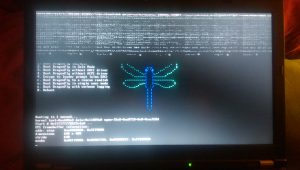Sepherosa Ziehau has an update for the Realtek re(4) network driver. Try it if you have the hardware, whether older or newer.
If for some reason smartmontools seems to think your disks aren’t SMART-capable, force smartd to use SCSI ioctls. has a snippet to use in your smartd.conf for just that.
Sepherosa Ziehau has implemented direct input support for polling, which will affect you most directly if you have an 10G ix(4) card. His commit message lists the performance improvements.
I installed a DragonFly snapshot on a Lenovo x220 last night. I went for a EFI install, even though the x220 has a “Legacy” option. When I booted, it looked like this:

It successfully booted, but once it hit the kernel load, it started printing to the top of the screen in that lovely repeating pattern you see.
Matthew Dillon helpfully pointed out that the DRM and i915 modules needed to be loaded. Hitting ‘9’ during the bootloader countdown got me to a prompt where I could type:
drm_load="YES" i915_load="YES"' kern.kms_console=1 menu
Which brought me back to the boot menu, but this time it loaded those additional modules to support the Intel video chipset – and it worked!
These lines can go in /boot/loader.conf for permanent use.
Update: accelerated X will need a different setup – see my later post.
Already overflowed to next week.
- New story: Savaged by Systemd. Lucas, what hast thou wrought?
- A few questions about BSD
- FreeBSD package management with Pkg (1/2). Applies to DragonFly, too.
- OpenBSD Community goes platinum.
- OPNsense 17.7.1 released.
- FreeBSD 10.4-BETA3 Available.
- A Brief History of Solaris (SunOS) Ports. Technically a BSD. (via)
- My first patch to OpenBSD. (via)
- Getting acme.sh to renew certs via cronjob on FreeBSD
- GSoC 2017 Reports: Add SUBPACKAGES support to pkgsrc, part 1. (via)
- Best BSD for Kaby Lake w/ Integrated Graphics.
- FreeBSD – what processes in what jails are using swap?
- LLVM libFuzzer and SafeStack ported to NetBSD. (via)
- OpenBSD on the Lenovo Thinkpad X1 Carbon (5th Gen). There’s a cost-saving tip in there for anyone planning a purchase.
- Solaris reported dead again. Illumos is working fine, though.
Matthew Dillon’s been using a Kabylake NUC for a DragonFly workstation and it’s generally working out well. It’s tiny enough to lose on a desk, in my opinion. He added performance details and a screenshot. The Specific Configs page has his notes, recorded, too.
Related laptop tip: If you have a Lenovo Yoga and can’t mount the drive after install, various sdhci modules may be the answer. Update: definitely the answer.
This happened a while ago, and I’m just catching up to it: the virtio_scsi(4) driver has been added to DragonFly; ported from FreeBSD and worked on by a number of people. ‘man virtio‘ if you want background.
If you are running DragonFly on a Ryzen CPU, this commit will fix (work around?) a hardware bug. I have not looked at how other operating systems may be addressing it, but it may be interesting to contrast.
Remember the firmware in userland idea I linked to before? Here’s the written plan/proposal.
If you’ve got a Skylake CPU, setting P state won’t save you as much energy as powerd(8)‘s -c option, according to Sepherosa Ziehau.
Bryan C. Everly eventually figured out how to configure his ThinkPad x230 so that the TrackPoint worked in xorg, and he wrote it down.
Do you have an isp(4) device? That would be a Qlogic SCSI/Fibre adapter. If you do, firmware handling has changed internally, thanks to Jan Sucan. I think configuration is unchanged, however.
There’s an update for the i915 (Intel) driver that is mostly of interest to you if you have a more recent processor. It looks to be mostly bugfixes.
If you’re looking for hardware RAID on DragonFly, here’s some brief notes on what should work. Areca and LSI are the hardware names to watch for. The person who asked the original question pointed to earlier benchmarks, which I may have linked before.
Thanks to Imre Vadasz, your Haswell, Atom SoCs, Skylake, and Kaby Lake CPUs will now recognize the ig4 device on the associated motherboard. I think it does something with ACPI? I have always been hazy on smbus device functions.
Radeon hardware support in DragonFly has been moved up to match what’s in the Linux 4.7.10 kernel. If you have a R9 290 GPU, there’s some tweaks you may need.
(n.b. may be unnecessary now from later commits; I don’t have the hardware to check.)
For some reason I am completely unfamiliar with this standard, but UHS-1 support for Secure Digital cards has been ported to DragonFly by Imre Vadasz, for a limited range of models. UHS stands for “Ultra High Speed”, so perhaps it’s clear what that standard does for you.
If your DragonFly system’s Intel network device doesn’t seem to pick up on DHCP, try turning on polling. This may already be a nonissue, but it doesn’t hurt to mention it.
Update: fixed.
Imre Vadasz added support for ADMA2 transfers in DragonFly. It doesn’t lead to a huge performance boost – yet. It can be turned on and off, but requires Intel chipsets.
Mobile Skylake CPUs appear to have issues with power management and direct video rendering. There’s potential fixes on the horizon, but until then, be aware if you have that specific hardware and software mix.
